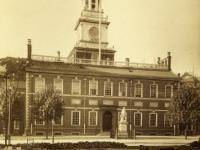This blog was posted on behalf of Sarah Sharp, Global Educator for World Heritage Philadelphia
Philadelphia’s new status as a World Heritage City (WHC), achieved in 2015, energizes us to think in new ways about the city in which many of us live. Since this designation exists for over 200 cities around the world, we can now take the time to compare and contrast Philadelphia with other exciting WHCs. We have a unique opportunity to work with students to understand our past as well as our current social, economic, political, and cultural features. We may also see how other WHCs address major issues and concerns similar to or different from our own, both past and present, such as immigration, leadership, and trade, as well as the connections across these matters. In other words, we can create a global context for our city’s great history. Finally, by designating other WHCs as Philadelphia’s “cultural siblings”, we can assume that an intriguing type of equality exists between our city and so many urban centers around the globe.
As teachers, we can play with this idea of WHCs as “cultural siblings” and see what happens, using the examples of Vienna, Cairo, and Havana. Here’s the first question. What was life and leadership like in these other cities when Philadelphia was young? In the 1680s, the people of Vienna, Austria successfully pushed back a major Turkish assault which led to a key building boom throughout the city. Unlike Philadelphia, however, the entire city was newly ringed with a defensive wall. Cairo’s history in this same era remained under Ottoman reach and rule, yet Mamluks controlled local leadership. In Havana, during the mid-17th century, the Spanish monarchy ruled over local residents and city construction included building a massive infrastructure to assist shipping and trade, and as well as a protective wall around a portion of the city.
Now, looking at Philadelphia’s early history, ask students how William Penn’s approach and plan sit within the context of these other WHCs. During the colonial era, Philadelphia drew its residents from across the globe, including Asia, Europe, Africa, and the Americas. The familiar story of Penn’s grant and the settling of Philadelphia in the late 1600s contains many stories that chronicle economic, civic, and religious leadership across the region as well as migration and immigration to the Delaware Valley. The Historical Society of Pennsylvania (HSP) contains major collections of papers of important early Philadelphia economic and political leaders such as Levi Hollingsworth (Hollingsworth family papers 1748-1887) Charles Jones (Charles Jones papers 1671-1689), and Jonah Thompson (Jonah Thompson collection of colonial Pennsylvania documents 1683-1854). HSP also holds records of the British Board of Trade (Great Britain Board of Trade records 1675-1782) which illuminate efforts to regulate Pennsylvania’s economic activities as a British colony. Within the decade of the 1690s, the city had a new civil government, established a thriving economic market, and became the major port on the Delaware River for the bustling colony as well as for this portion of the British empire within North America. If we wish to dig even more deeply, HSP has much information about the city’s Free Society of Traders (The articles, settlement, and offices of the Free society of traders in Pennsilvania : agreed upon…) to show us the wealthy leaders in the Society Hill neighborhood.
So, here is a chance to uncover Philadelphia’s colonial past in a global context. We suggest allowing students to investigate the histories of other WHCs at www.ovpm.org. Then compare and contrast those stories to Philadelphia. How were they similar? How were they different? What surprised the students about the history of the other WHCs? What additional questions did students have about these “cultural siblings” that they would like to try to answer?
Finally, it is important that students know that even in our colonial years we established major trade and cultural connections, proving that Philadelphia has always been an international city!
Just to help students get started, here a very informative websites, complete with timelines and lots of local historical details: http://philadelphiaencyclopedia.org/

